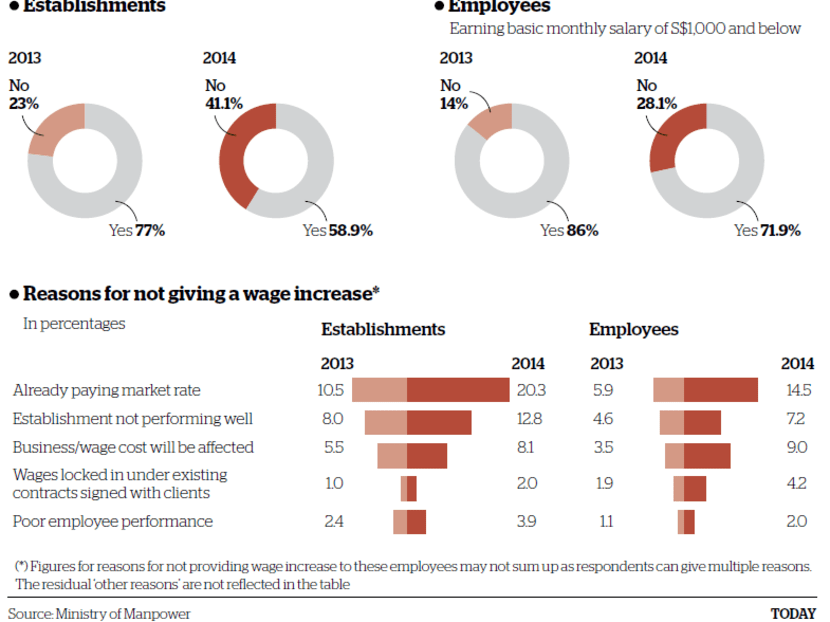Built in rises for low-wage workers showing results
SINGAPORE — Three years after the National Wages Council (NWC) urged built-in wage increases for low-salaried workers, results are beginning to show, based on the wage practices report released by the Ministry of Manpower (MOM) today (June 4).

Relatively fewer full-time resident workers last year had monthly basic salaries of S$1,000 and below. The proportion is estimated to have fallen from 9.8 per cent in 2012 to 6.8 per cent. TODAY file photo
SINGAPORE — Three years after the National Wages Council (NWC) urged built-in wage increases for low-salaried workers, results are beginning to show, based on the wage practices report released by the Ministry of Manpower (MOM) today (June 4).
Low-wage workers — those who earned a basic monthly salary of up to S$1,000 — who received these built-in wage increases saw an average basic wage increase of 14.2 per cent last year, outpacing the 8.4 per cent received by all rank-and-file staff in these establishments.
Overall, such low-wage workers now make up a smaller proportion of the workforce — 6.8 per cent last year, down from 9.8 per cent in 2012.
In real terms, some 50,000 to 60,000 workers have crossed the S$1,000 mark in basic monthly salary over the same period, showed figures from the labour movement.
Based on the MOM report, almost 60 per cent of employers said that they gave or intend to give wage increases to their workers last year, similar to the proportion in 2012 but lower than the 77 per cent in 2013.
(Click to Enlarge)

Establishments in the administrative and support services sector led in giving the minimum built-in wage increase of at least S$60. “This was likely driven by the cleaning sector which saw the implementation of the mandatory progressive wage model over the year”, the MOM said in the report.
Of remaining employers which did not grant wage increases, about half said that they were already paying salaries in line with market levels. About 13 per cent cited poor business performance while 8 per cent said doing so would impact their business costs.
The NWC, which stopped recommending a quantum for wage increases in its annual wage guidelines for decades, began doing so again in May 2012, recommending a minimum S$50 wage hike for low-wage workers earning up to S$1,000.
A month earlier, top economist and former NWC chief Lim Chong Yah had called for “shock therapy” to drive wages for the low-salaried. He proposed those earning below S$1,500 a month have their pay increased by 50 per cent over the next three years, while freezing wages for those making at least S$15,000. This proposal was met with swift rebuttals from cabinet ministers that it was too risky.
Economists and observers interviewed today felt that a gradual approach has allowed for more sustainable salary growth for low-wage workers.
Economist Selina Ling, the head of treasury research at OCBC Bank, said the decrease in proportion of low wage workers is “significant”.
A “shock therapy” approach can be unpredictable — in the 1980s, Singapore pushed up wages and a recession followed in 1985. “It will be like a boomerang that hits you back in the face”, said Ms Ling. Also, small and medium enterprises (SMEs) might not be able to bear such a heavy burden.
Mizuho Bank senior economist Vishnu Varathan supported pegging wage increases to productivity gains so that low-wage workers can benefit over the longer term. This is because productivity gains leading to profits raises the prospects of wage increase for the worker instead of imposing a one-off wage increment, he pointed out.
Mr Varathan said a narrower income inequality gap is likely to be seen in five to ten years’ time, and suggested employers redesign low-wage jobs to incorporate technology and increase job satisfaction in the meantime.
Singapore Business Federation Chief Operating Officer Victor Tay pointed out that manpower costs are the biggest expenditure for businesses today. “While motivated staff will provide better productivity, it has become loss-making for many companies to increase wages when productivity is not catching up,” he said.
He suggested employers tap more into the variable wage component in the wage structure or let staff have greater profit share through variable bonuses. In the sales industry for example, this will motivate the workers to aim for better sales, while allowing companies to be more flexible in managing costs during downturns, he added.
Association of SMEs president Kurt Wee said some companies still struggle to increase wages for the low-salaried as they are still unable to improve their productivity levels.
“What we could do is to unleash a greater number of job-process or work-flow reengineering specialists in each of these many industries (to) help those that have not yet undergone a sufficient level of upgrading catch up with the rest,” he said, adding that even so, the smallest of companies might not be able to keep up.






